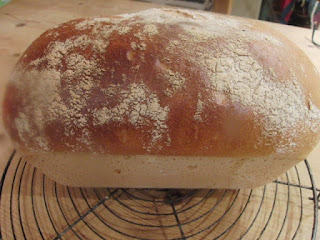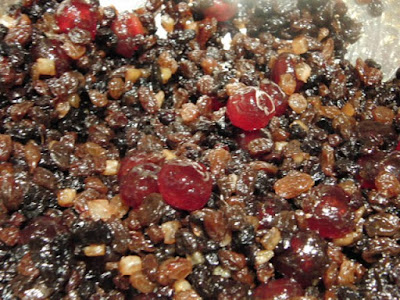Many of us like to buy free range or organically raised chicken these days for our sunday roast, as well as free range eggs. And many more people are keeping the odd few hens in the garden for a fresh supply of free range eggs. Which is how I started. If you try keeping two or three chickens, and you enjoy doing it, it's not such a long way from trying your hand at rearing chicken for the table. In modern farming practice, egg rearing and chickens for meat are entirely separate operations, as are dairy and beef farming, but this is a modern convention, and traditionally both operations would form part of poultry, or indeed cattle husbandry. If you keep a traditional breed of bird and allow them to breed, (ie you keep a cockerel) each year you will have on average half females for your egg supply,and the other half cockerels that you can fatten for the table.
Or, if you don't want, or can't keep a cockerel, you could just buy in day old chicks as I did this year for my first experiment in raising birds for the table. I used Hubbards, (from FAI Farms in Oxford,) a modern hybrid specially bred for free range production. They were very good, and not difficult to rear, but I would like to try some traditional breeds and next time I will probably have some Marans,or Light Sussex, and see how I get on. I have had Light Sussex before but I failed to fatten them effectively and they were a bit disappointing. With my Hubbards I fattened them on rolled barley, and if it weren't illegal to say so, I might say that I had given them a plentiful supply of table scraps, but of course, such cavalier disregard for the law of the land would be quite reprehensible. In fact, I think the current madcap Defra legality is that it's ok to feed scraps if you're going to eat the chickens yourself, but not if anyone else is going to have any. You might conclude that the best thing is to please yourself and say nothing, but of course, I couldn't possibly comment.
My Hubbard chicks cost me about 80p each. If you don't have a broody hen, you have to keep your day old chicks under a heat lamp for the first few weeks of their lives, until they are well feathered enough to keep warm on their own. But the broody really is the way to go if you can, she does all the hard work for you, and after about six weeks, she will decide that they are old enough to manage on their own, and will gradually leave them to it.
Hubbards are hybrid chickens intended to be raised on free range or organic methods, and are expected to be ready for despatch at around 12-14 weeks. And frankly if they had been, my costs would have been quite a bit less. Most supermarket chickens are killed at around 6 weeks or so but my chickens were despatched at 22 weeks, and weighed between 4 and 8 lbs, most being around the six pound mark or three kilos. With hindsight, I would have preferred to have had some smaller birds, around 3-4 lbs and I could have killed these at an earlier stage. I also think I should have had the birds in their own enclosure, instead of just generally roaming around the garden with the layers and the ducks, as I think I could have kept a closer eye on their diet and probably fattened them a bit sooner. Also this would have enabled me to keep a closer account of the costs of raising the birds, since I really don't have much of an idea of what the total costs really were.
We have roasted two of the chickens so far, and the flavour is really lovely. I roasted them for slightly longer than usual, and at a lower temperature. The dark meat is darker than usual,and the breast tender and full of flavour. I have some birds jointed, but with Christmas getting in the way we have yet to try any stir fried etc. but I think it will be very good.
 Here are a few pictures of the birds from June to November this year. First from June,the broody, with the newly arrived day old chicks. I slipped them under her late in the evening and she took to them straight away. This old bird is an Araucana crossed with a Maran, she has raised several broods of chicks, is very hardy, and still lays a lovely blue egg on a regular basis. She's definately my best bird.
Here are a few pictures of the birds from June to November this year. First from June,the broody, with the newly arrived day old chicks. I slipped them under her late in the evening and she took to them straight away. This old bird is an Araucana crossed with a Maran, she has raised several broods of chicks, is very hardy, and still lays a lovely blue egg on a regular basis. She's definately my best bird.These two are from June - the broody still looking after the chicks, showing them how to find insects, in this case a delicious ants nest in the woodchip path in the veg garden, and all the while keeping a lookout for any danger
This is how they looked in September, growing well but not fat enough yet
October and still growing well

November
I know that lots of people have a problem relating the living creature with the roast dinner on the table. I think it's a normal reaction, and for myself I still don't find the despatching of any living creature easy. But if you're going to have meat on your plate the simple fact is that something has to die in order for it to get there. I have to steel myself to it, and ensure I acheive a quick end for the birds. On this occasion, because there were so many birds to go at once, I employed the services of Sid my retired butcher friend who killed the birds for me and with the use of his plucking machine, saved me many hours of work over that weekend. And I have the consolation that my birds had lived as good a life as any chicken could have wanted, enjoying fresh air, grass, small numbers and a quick and stress free end. I wish I had the means to ensure that every pork chop and beef steak we eat has had a similar history and provenance.



















































